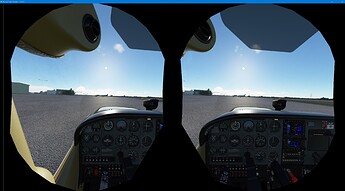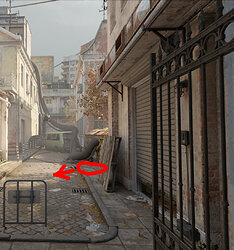I wanted to further comment on this and I’ve taken a screenshot for another unrelated problem which gave me the idea to specifically compare the G2 and Index headsets with this aircraft cockpit as a reference.
I’ll use this screenshot for illustration only (just to remind the disk of clarity limits I can observe)*:
I’ve compared both in placing me in front of the attitude indicator and looking directly to its center point, with the Cessna logo on the yoke visible near the bottom of the view, then in moving only the eyes around.
Reverb G2:
- I can see the attitude indicator gauge sharp overall.
- The right most side of the airspeed indicator is showing slight blur, increasing as you look further to the left.
- The left most part of the altitude indicator is showing the same level of blur increasing as you look further to the right.
- The 3 gauges below (Turn Coord, Compass, VSI) are slightly more blurry and their lowest part is becoming sensibly less sharp.
- The RPM indicator is heavily blurry, you can still decode the writing but not read it at a glance.
To keep it simple, trying to read anything beyond the middle of the 5 gauges surrounding the attitude indicator requires moving the head.
Valve Index:
- There is no blur vertically from top to bottom. I can read clearly the Cessna logo and even see no blur on the features on the floor.
- I can see no blur from the left most gauge (fuel QTY) to the left edge of the Garmin GPS.
The Index has a large edge-to-edge clarity where you can read easily anything within the 3 black grooves as clearly as in the center, and anything quite far beyond still, with minimal blur. You don’t feel the need to turn the head to read better.
Comparing effective resolution:
- In the entire Index region I’m describing, the effective perceived resolution is higher than on the Reverb G2 image seen when reading the “100 knots” mark in the airspeed indicator, or the aircraft symbol in the center of the compass.
- In the disk of clarity region of the G2 I’m describing, the effective perceived resolution is higher than on the Index center, there is no question there.
Comparing optics (simple test in SteamVR):
- launch SteamVR Home
- set Alyx 17 environement
- navigate to the 2nd part of the environment (after passing through the porch on the left)
- go near the wall onto which passes a big cable
- turn around and look at the wall at the opposite side where there is a Russian poster/writings
- turn your head left and right and see how the wall and poster are geometrically deforming
- remove the front mask and hold the headset closer to your eyes and repeat.
There is a distance were there is no deformation at all (in addition to increased FOV and the perception of a wider sweet spot we all know already), and if you get closer to the point your eyes are nearly touching the lenses, the wall deformation will come back but this time reversed (like farther away it is barrel distortion and closer it is pincushion).
I don’t see any distortion whatsoever with the Index regardless of eye relief adjustment. It is possible SteamVR is also varying the pre-distortion to compensate for the eye relief distance changes too, but I just think the optics have a better designed sweet spot allowing such variability optically only.
Do you see this happening with yours too?
*this screenshot comes from an unrelated discussion:
LOD Problems - Distances revisited - #32 by CptLucky8

